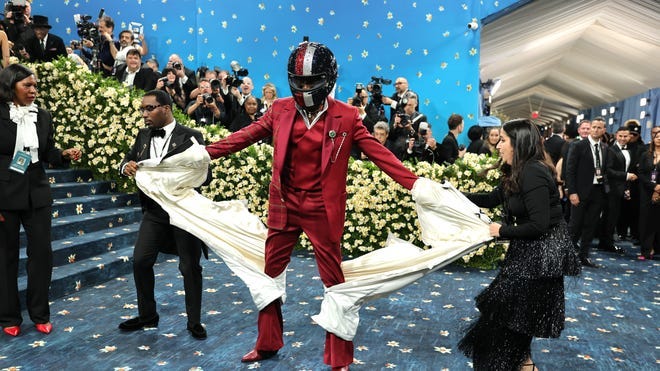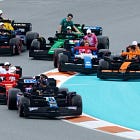How F1 Movie Ups the Ante on Brand-Narrative Integration
Welcome to Sportainment 2.0
Welcome to Business of Speed.
In case you missed it:
If someone forwarded you this email, consider supporting independent coverage and analysis of the business of Formula 1.
Welcome to Sportainment 2.0.
What is Sportainment 2.0?
It’s where, in content, brands aren't just sponsors; they’re characters in the story, helping to advance the narrative and build a world.
Imagine a Hollywood blockbuster that doesn't merely feature brands, it builds its story around them. F1 Movie, is a marketing masterclass set for global release on June 25, 2025. This is a groundbreaking evolution, transforming brands from mere background extras into lead characters.
Barbie set a high benchmark in 2023 with its pink tidal wave, turning everything from Xboxes to Airbnb listings into neon-colored spectacles. Yet Barbie's strategy was external—it covered the globe in pink paint without inviting brands inside the narrative itself. F1's approach is radically different. Brands like Expensify, Tommy Hilfiger, Heineken 0.0, and IWC Schaffhausen don’t just advertise; they integrate seamlessly into the film’s fabric, becoming integral to the narrative rather than intrusive distractions.
Instead of creating superficial sponsorships, the film establishes an entire fictional eleventh F1 team—APXGP—a richly detailed and convincingly real one, sponsored by elite global brands.
In the new F1 25 video game by EA Sports, you can play as the APXGP team and even complete challenges to view more actual film content.
The brilliance here is authenticity.
What they've pulled off is genuinely impressive. They’ve built a fictional race team with real brand positioning and equity that might even surpass actual midfield teams like Kick Sauber and Haas.
The result is a believable racing outfit with genuine commercial appeal.
Consider Tommy Hilfiger’s bold move: At the Met Gala, actor Damson Idris arrived dramatically in an APXGP team car, dressed initially in a branded racing suit. With the swift removal of the suit, revealing a tailored Tommy Hilfiger tuxedo beneath, the brand achieved immediate virality.
Sign-ups for Expensify quadrupled within hours. This event was cultural theatre, exemplifying a new standard for narrative-driven brand partnerships.
Equally impressive is Heineken 0.0’s nuanced strategy. Directed by Joseph Kosinski, the film’s promotional content, featuring Brad Pitt and Damson Idris, cleverly addresses social stigmas surrounding alcohol and moderation. As Heineken’s global head, Nabil Nasser, explains, the partnership is designed "to redefine what it means to choose moderation today." The campaign leverages the movie’s global appeal to embed Heineken’s moderation message organically within a thrilling narrative, transcending typical brand visibility.
Perhaps most strikingly innovative is Apple’s contribution as the film’s distributor. Using cutting-edge "haptic trailer" technology, viewers physically feel racing sensations through their iPhones, creating an immersive experience that breaks new ground in film marketing. This unprecedented tactile innovation underscores the evolution of brand integration, making F1’s promotional strategy as experiential as it is visual and auditory.
Apple even dedicated the first 2:30 of its WWDC event to promoting the film, complete with a skit featuring SVP Craig Federighi.
This strategic integration extends well beyond mere branding. By filming during actual Formula 1 weekends, the movie captures genuine racing footage, blurring the lines between fictional storytelling and real-world sport. Fans even sport APXGP merchandise at real races, creating a feedback loop where fictional and real-world fandoms reinforce each other.
At a budget exceeding $250 million, this is an ecosystem of brand storytelling. Expensify’s CEO, David Barrett, even calls it "possibly one of the best brand placement opportunities ever," expecting a significant business impact long after the credits roll.
In this new era of sportainment, traditional marketing metrics fade against the sustained value created by narrative authenticity. The F1 film doesn't merely market products, it integrates them into the narrative’s DNA, potentially redefining how we measure marketing success.
As audiences increasingly expect richer, more immersive experiences, the F1 film sets a compelling precedent. It invites brands not just to be seen but to become part of the story itself, marking a transformative moment in how entertainment and commerce collaborate. For marketers and brands, the message is clear: the future belongs not to those who shout the loudest but to those who can authentically embed themselves in compelling narratives.
If you're tracking the business of motorsport—not just the lap times—this is the moment to stay sharp. The politics are intensifying, the money is flowing, and the stakes are higher than ever.







